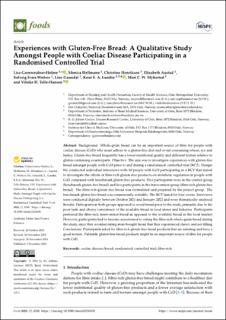| dc.contributor.author | Hellmann, Monica | |
| dc.contributor.author | Henriksen, Christine | |
| dc.contributor.author | Austad, Elisabeth | |
| dc.contributor.author | Ivara Watters, Solveig | |
| dc.contributor.author | Gaundal, Line | |
| dc.contributor.author | Lundin, Knut | |
| dc.contributor.author | Myhrstad, Mari | |
| dc.contributor.author | Telle-Hansen, Vibeke | |
| dc.date.accessioned | 2024-01-10T11:56:52Z | |
| dc.date.available | 2024-01-10T11:56:52Z | |
| dc.date.created | 2023-12-01T11:37:05Z | |
| dc.date.issued | 2023 | |
| dc.identifier.issn | 2304-8158 | |
| dc.identifier.uri | https://hdl.handle.net/11250/3110842 | |
| dc.description.abstract | Background: Whole-grain bread can be an important source of fibre for people with
coeliac disease (CeD) who must adhere to a gluten-free diet and avoid consuming wheat, rye and
barley. Gluten-free bread frequently has a lower nutritional quality and different texture relative to
gluten-containing counterparts. Objective: The aim was to investigate experiences with gluten-free
bread amongst people with CeD prior to and during a randomised controlled trial (RCT). Design:
We conducted individual interviews with 10 people with CeD participating in a RCT that aimed
to investigate the effects of fibre-rich gluten-free products on metabolic regulation in people with
CeD compared with benchmark gluten-free products. Five participants were in the control group
(benchmark gluten-free bread) and five participants in the intervention group (fibre-rich gluten-free
bread). The fibre-rich gluten free bread was formulated and prepared by the project group. The
benchmark gluten-free bread was commercially available. The RCT lasted for four weeks. Interviews
were conducted digitally between October 2021 and January 2022 and were thematically analysed.
Results: Participants in both groups appeared to avoid bread prior to the study, primarily due to the
poor taste and chewy consistency of the available bread in food stores and bakeries. Participants
preferred the fibre-rich intervention bread as opposed to the available bread in the food market.
However, participants had to become accustomed to eating the fibre-rich whole-grain bread during
the study, since they avoided eating store-bought bread that they experienced chewy and not filling.
Conclusions: Participants asked for fibre-rich gluten-free bread products that are satiating and have a
good texture. Palatable gluten-free bread products might be an important source of fibre for people
with CeD. | en_US |
| dc.language.iso | eng | en_US |
| dc.rights | Navngivelse 4.0 Internasjonal | * |
| dc.rights.uri | http://creativecommons.org/licenses/by/4.0/deed.no | * |
| dc.title | Experiences with Gluten-Free Bread: A Qualitative Study Amongst People with Coeliac Disease Participating in a Randomised Controlled Trial | en_US |
| dc.type | Peer reviewed | en_US |
| dc.type | Journal article | en_US |
| dc.description.version | publishedVersion | en_US |
| cristin.ispublished | true | |
| cristin.fulltext | original | |
| cristin.qualitycode | 1 | |
| dc.identifier.doi | 10.3390/foods12234338 | |
| dc.identifier.cristin | 2207282 | |
| dc.source.journal | Foods | en_US |
| dc.source.volume | 12 | en_US |
| dc.source.issue | 23 | en_US |

